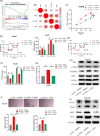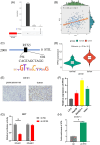Regulatory factor X-5/SCL/TAL1 interruption site axis promotes aerobic glycolysis and hepatocellular carcinoma cell stemness
- PMID: 39718123
- PMCID: PMC11724169
- DOI: 10.1002/kjm2.12922
Regulatory factor X-5/SCL/TAL1 interruption site axis promotes aerobic glycolysis and hepatocellular carcinoma cell stemness
Abstract
The incidence and development of various tumors, such as hepatocellular carcinoma (HCC), are linked to tumor stem cells. Although research has revealed how important SCL/TAL1 interruption site (STIL) is in many human tumors, the impact of STIL on HCC stem cells is poorly understood. This study aimed to examine the regulatory mechanisms and the function of STIL in the stemness of HCC tumor cells. Bioinformatics analysis was applied to determine the STIL and regulatory factor X-5 (RFX5) expression in HCC tissues. Immunohistochemistry (IHC) was used to detect the expression of STIL and RFX5 in HCC tissues. Quantitative real-time polymerase chain reaction was utilized to measure the STIL and RFX5 expression levels in HCC cells. The viability of the cells was assessed by the Cell Counting Kit-8 assay. The sphere formation assay was used to evaluate the sphere-forming capacity. The expression levels of the stem cell markers SOX2, Oct-4, CD133, CD44, the glycolysis-related proteins LDHA, HK2, AKT, p-AKT, and β-catenin were assessed by Western blot. Lactate production, oxygen consumption rate, and extracellular acidification rate were measured to assess the glycolytic capacity of HCC cells. Chromatin immunoprecipitation and dual-luciferase experiments were performed to validate the connection between RFX5 and STIL. Bioinformatics analysis determined that STIL exhibited high expression in HCC tissues and was enriched in the glycolysis pathway. In addition, the expression of glycolysis marker genes was positively correlated with STIL expression. Cell experiments verified that the activation of the glycolysis pathway by overexpression of STIL promoted stemness in HCC. Molecular experiments also revealed the binding relationship between STIL and RFX5. IHC detected high expression of STIL and RFX5 in HCC tissues. Cell functional experiments revealed that RFX5 could influence the HCC cells stemness by activating the STIL transcription via the glycolysis pathway. This study identified a novel role for the RFX5/STIL axis in HCC progression, which may offer treatment targets for HCC.
Keywords: RFX5; STIL; glycolysis; hepatocellular carcinoma; stemness.
© 2024 The Author(s). The Kaohsiung Journal of Medical Sciences published by John Wiley & Sons Australia, Ltd on behalf of Kaohsiung Medical University.
Conflict of interest statement
The authors declare no conflict of interest.
Figures






Similar articles
-
Regulatory factor X5 promotes hepatocellular carcinoma progression by transactivating tyrosine 3-monooxygenase/tryptophan 5-monooxygenase activation protein theta and suppressing apoptosis.Chin Med J (Engl). 2019 Jul 5;132(13):1572-1581. doi: 10.1097/CM9.0000000000000296. Chin Med J (Engl). 2019. PMID: 31188160 Free PMC article.
-
RFX5 promotes the progression of hepatocellular carcinoma through transcriptional activation of KDM4A.Sci Rep. 2020 Sep 3;10(1):14538. doi: 10.1038/s41598-020-71403-1. Sci Rep. 2020. PMID: 32883983 Free PMC article.
-
Transcription Factor Activating Enhancer-Binding Protein 4/Acidic Nuclear Phosphoprotein 32 Family Member E Axis Increases Lactate Production to Promote Triple-Negative Breast Cancer Stemness.J Biochem Mol Toxicol. 2025 Jul;39(7):e70350. doi: 10.1002/jbt.70350. J Biochem Mol Toxicol. 2025. PMID: 40557837
-
Exosomal ETV4 Derived From M2 Macrophages Induces Growth, Glycolysis and Stemness in Hepatocellular Carcinoma by UpRegulating SULT2B1 Expression.Liver Int. 2025 Apr;45(4):e16197. doi: 10.1111/liv.16197. Epub 2024 Dec 6. Liver Int. 2025. PMID: 39639836
-
Transcription Factor MAZ Potentiates the Upregulated NEIL3-mediated Aerobic Glycolysis, thereby Promoting Angiogenesis in Hepatocellular Carcinoma.Curr Cancer Drug Targets. 2024;24(12):1235-1249. doi: 10.2174/0115680096265896231226062212. Curr Cancer Drug Targets. 2024. PMID: 38347781
References
-
- Najafi M, Farhood B, Mortezaee K. Cancer stem cells (CSCs) in cancer progression and therapy. J Cell Physiol. 2019;234(6):8381–8395. - PubMed
MeSH terms
Substances
LinkOut - more resources
Full Text Sources
Medical
Research Materials
Miscellaneous

